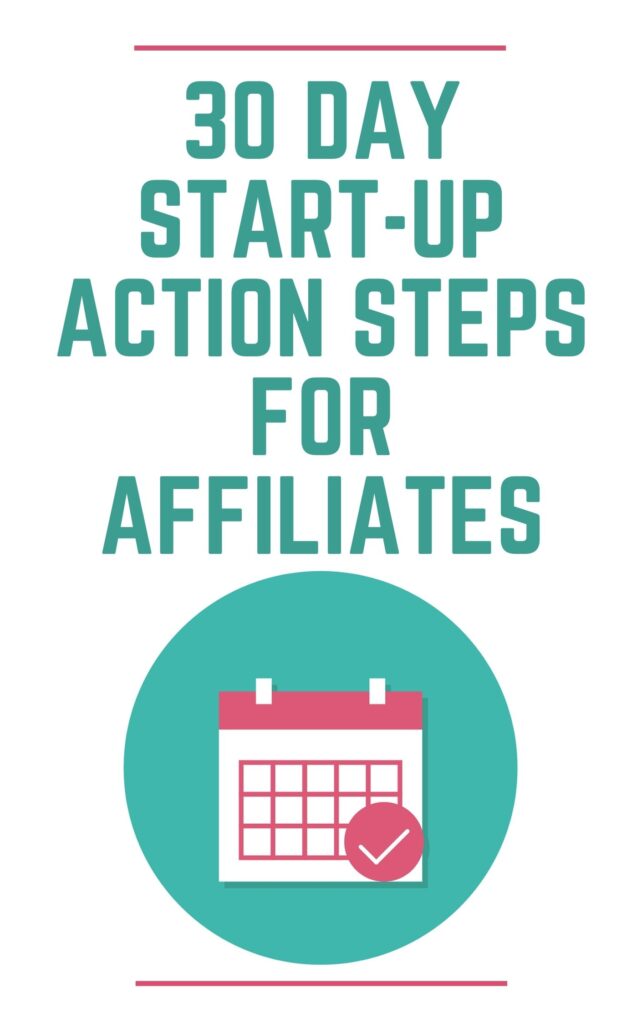If you’re considering affiliate marketing in the new year, this post is for you! In it, you’ll find a 30 Day Start-Up Action Plan for Affiliate Marketing.
30 Day Start-Up Action Steps for Affiliates
Starting an online business as an affiliate marketer is one of the easiest ways to get started earning money on the Internet. You don’t have to take the time or effort to create your own products, recruit affiliates for them, and go through all of the launch task details.
Instead, you get to hit the ground running with easy content that helps guide consumers to the products that will serve as solutions to their problems. In exchange for your advice, when the customer purchases from the vendor, you will be paid a commission.
The only problem facing most newbie affiliate marketers is that they are given a broad overview of what to do. What you need is a daily action step to implement so that by the end of a 30 day period, you are beginning to consistently publish product reviews that will bring in money.
The steps listed below are grouped into the span of five weeks, with a day off to do as you please. Feel free to accomplish more than one task per day, if you have time – or, stretch it out a little longer if you feel the need to.
Week 1: Research Tasks and Decision Time
During the first week of your affiliate marketing start-up plans, you will be taking care of an aspect of business building that many fail to do. Instead, they jump right into the content creation step, hoping to rake in overnight profits.
Because they didn’t take the time to create a foundation that will perform well in their niche, they will be left confused when they fail to get traffic and conversions with their product reviews.
Day 1 – Take a Day to Read Affiliate Reviews
On day one, you want to go online and begin researching a variety of niche affiliate review blogs. You need to look at those that review products on a broad scale, as well as for narrow niche topics.
Make some mental notes to yourself about how you feel about the quality of these reviews. If you notice anything is lacking, jot that down. If anything sticks out that impresses you, make a note of that as well.
Pay attention to everything about the affiliate review. It’s not just about the words that are written, it’s about the layout of the information, the white space, images that are used, the call to action, and more.
Day 2 – Spend This Day Watching Review Videos
On day two, you are going to continue analyzing other affiliates’ reviews, but this time you are going to specifically immerse yourself in video reviews. Even if you currently have no plans to utilize a multimedia approach, it’s important that you see how it’s being done because this is what will be competing with you if you are only using text.
You need to pay specific attention to how the video is being shot. Is the reviewer on camera, or you can you only see the product itself? Make a note about how long video reviews are generally in your potential niches. Look for forms of engagement, such as the number of likes or comments that a video has, too.
Day 3 – Research Your Tangible Monetization Options
On day three, you will take some time to research tangible commission opportunities for the various niche markets that you are considering. You can look on sites such as Amazon, Share a Sale, in Commission Junction.
You can also look on Google to find direct affiliate programs for vendors and manufacturers. For example, if one of the niches you are considering is survival, you can type in survival food affiliate program and besides being able to promote this type of product on Amazon, you may find companies who have a program that pays you directly.
Day 4 – See What Digital Products You Could Promote
On day four, you want to do the same thing you did on day three, only with digital info products. You are looking for both quality and quantity, to ensure that there are enough solid products on the marketplace for you to promote.
For digital products, you might look on sites like ClickBank, Warrior Plus, JVZoo, and Udemy. Not only are you looking for courses, but sometimes you will find tools that you can review of a digital nature.
Day 5 – Make the Commitment to a Niche
On day five, you want to spend some time weighing the pros and cons of each of the niche markets that you were considering. By the end of the day, make a final decision on which niche you plan to attempt to make money with.
Day 6 – Find a Keyword-Rich Domain Name
On day six, conduct some basic keyword research and began mixing and matching the words until you come up with an available domain name that makes sense for your brand.
Make sure you invest in a dot com domain so that you are utilizing the extension that most consumers automatically type in when they are trying to reach a site. You don’t want a competitor to scoop up this extension if it becomes available and you have a different one.
Week 2: Setting Up Your Affiliate Site
Week two of this journey is when you will go through the technical set up steps to make your affiliate website go live. There are many online tutorials that will show you a step-by-step process of how to do these steps, but let’s go over the order in which they should take place and what needs to happen.
Day 7 – Set Up Your Hosting Account
You already have your domain so, so it’s time for you to register for a hosting account. With a single affiliate site to begin with, you don’t need a big plan. You can always level up with your hosting at any time if you intend to branch out and grow your business.
Day 8 – Install WordPress for Your Review Blog
Once your hosting is set up, go through the simple steps to install WordPress on your domain where your review blog will be housed. This is a quick and easy process, where you will enter some contact details and then let the system handle the installation.
Day 9 – Go Through Your Settings and Plugins
On day nine, you will revisit the dashboard of your WordPress blog and go down the left sidebar through each option so that you can ensure it is set up the way you want it to be.
If there are any plugins that you want to use to help you with search engine optimization or socialization, you can install and activate those at this time. Make sure that every time you install a plug-in, and make it not work.
Day 10 – Pick a Theme and Professional Design
Day ten is when you get to choose how your affiliate review blog will look to others. If budget is not an issue, then you can pay for a professional theme. But keep in mind there are plenty of free WordPress themes that you can download and use on your site.
If you want to brand your online business as an affiliate, you can outsource the creation of site graphics, such as your header. If you don’t know how to do this professionally, it’s always better to hand it over to someone else so that your site doesn’t reflect the work of an amateur.
Day 11 – Create the Proper Affiliate Pages
On this day, you will be setting up any pages that you want on your blog. Pages are different from posts, and they often show up at the top of your website, Right below the header.
Some of the pages you may want to create include an About page, a Contact page, and any pages that are required by any of the affiliate platforms you will be sending traffic to that identify you as an affiliate who earns a commission if they buy through that link.
Day 12 – Categorize Your Upcoming Reviews
Today, you will be creating the categories for your review site. These are the subtopics where you will assign each product review so that when a human or search bot arrives on your domain, they can easily navigate to the content they most want to see.
For example, if you are in the anti-aging niche, you would have categories such as skin care, mobility, finances, socialization, fitness, etc. If someone lands on your site, and they only want to read about your skin care advice, they should be able to click the category and easily see all of your content that is relevant to that topic.
Week 3: Set Up Your List Building Strategy
During week three, you will be taking the steps to ensure that you are able to contact the visitors to your site time and time again. The best way to do that is to build a list, and there are several steps involved in doing this.
Day 13 – Create a Lead Magnet Worth Subscribing For
This process starts with the creation of a lead magnet. This is your free gift that you offer to visitors in exchange for their name and email address. In order to build a list that rakes in money, you want to have a lead magnet that is irresistible. Take time to create one that wows your audience.
Day 14 – Analyze Several Email Autoresponders
Once it is created, do some research on the various email autoresponder systems that are on the market and choose one that you feel will work best for your needs. As a rule of thumb, it’s always best to go with one that has a proven track record so that you don’t lose all of your leads when a shady vendor quits supporting the too good to be true autoresponder system they created.
Day 15 – Sign Up for One and Create a List
On day fifteen, make your final decision about which autoresponder you will go with and sign up with the company. You will then create your very first list and give it a name. Make sure it is identifiable by the site and niche you have chosen so that on a later date, if you add another niche market to your autoresponder system, you will have no problem differentiating between the two.
Day 16 – Write Your Welcome Email
On this day, you will write your welcome email to those who sign up for your list. Your welcome email should detail a little about how you run your list, it should thank them for signing up, and it should deliver a link to your free opt in offer that was promised.
Day 17 – Grab Your Form Code and Install It on Your Blog
The next day, log into your email autoresponder system and go through the steps to create a form. When you get to the end and have finished designing it, you will copy the code it’s spits out and install it on your blog.
Day 18 – Test Your Autoresponder
Before you end all of your list building activities, you want to use the 18th day to test your autoresponder and make sure that it is working properly. If your welcome email includes the link to your freebie, make sure you test it and make sure that it works.
Week 4: Put Yourself on a Publishing Schedule
Week four for a new affiliate consists of ironing out your upcoming publishing schedule. This will determine what types of topics are published and on what day. It helps you space product reviews out and fill the gaps with niche value.
Day 19 – Pick 15 Tangible Products You’ll Be Reviewing
On day nineteen, you should go through and pick 15 tangible products that you want to review on your blog. Look for products that have the right price point for you to earn a decent commission and consider whether or not you want to write thorough reviews about a single product or deliver brief spiels about a top ten list of products.
Day 20 – Pick 15 Digital Products You’ll Be Reviewing
You are almost finished with your tasks at this point. Take today to select 15 digital products that you want to review for your blog. These can be a mix of info products that inform someone, coaching programs, memberships, or even digital tools.
Day 21 – Plan Time for Research and Information Gathering
On day twenty-one, spend the day gathering the research you need for your reviews. You can put the information in a swipe file that you can refer to as you write your review from scratch, so that you don’t have to revisit the product listing every time you want to learn more.
Day 22 – Order Products or Request Review Copies
On day 22, make a decision about which tangible products and digital products you want to personally invest in for your review process. You may not be able to afford to buy every single product for every review.
For the digital products that you are reviewing, you can either buy those or request a review copy from the vendor, if they are willing to give it. While they may say no initially, as your brand grows, they may be more willing to provide that at no charge.
Day 23 – Determine Which Reviews Will Have Multimedia
On day 23, figure out what media format you are going to use for each review. They don’t all have to be the same. You may have a text only review for some products, while others you devote to a video review.
This might be especially helpful if you have a product that you purchased and you want to conduct an unboxing video, which is popular among affiliate marketers using YouTube.
Day 24 – Assign a Publishing Date for Each Product Review
On the last day of week four, you want to go through your list of tangible and digital products and assign a publishing date for a review of that item. If you have chosen products from a variety of categories, this will help you prevent a repetitive pattern where you only review certain items for long stretches.
Week 5: Get the Reviews Ready and Send Traffic to Them
You are in the homestretch now! Week five is when everything begins to happen. You still have some decisions to make, but you will begin to see traction after your reviews go live on your blog.
Day 25 – Decide If You Want to Create or Outsource Your Reviews
On this day, you need to decide if you have the time and talent to write these product reviews yourself or if you need to outsource them to a freelance service provider to do the job for you.
Day 26 – Create a Template for How the Reviews Should Unfold
Regardless of whether you do it, or you have someone else create them, it may be helpful to whip up a template for how you want your reviews to unfold. You may have seen a certain style that impressed you early on in your research, and you can weave some of those elements into your own affiliate review template.
Day 27 – Carry Out the Product Review Process
At this time, you want to begin creating the product reviews that will go on your blog. Because you have already conducted all of the research, this should be a quick and easy job.
Make sure you add personalization to your reviews so that you develop a loyal following and fanbase who rely on your recommendations for their upcoming purchases. This is an ongoing step.
Every affiliate is different in terms of how much content they can get done in a single day. Some affiliates can barely eke out a single article, while others can whip up 20 to 40 pages per day.
If you have outsourced the content, make sure you go over it with a fine tooth comb so that you can spot any obvious misinformation, typos, or other errors. Be sure and run the review through Copyscape to ensure the content has not been ripped off.
Day 28 – Begin Queuing Up the Reviews to Drip Publish to Your Blog
On day 28, you can take the product reviews that are ready and queue them up in your blog so that they automatically publish for you over a period of time. You could choose to publish daily, a couple of times per week, or whatever works best for you.
However, if you want to develop a thriving affiliate review blog, you will need to be competitive with the consistency that you show in delivering fresh information to your target audience.
Day 29 – Write Emails to Your List Sharing the Review Links
On day 29, you want to create emails that will drip out to your subscribers on the same day that the product review goes live on your blog. Instead of having to wait for organic traffic, you will be sending people there to consume the information and also share it on social media.
Day 30 – Go to Applicable Social Networking Sites and Share the Links
On the last day of your startup action steps, you want to get in the habit of taking the link from your blog where you reviewed a product and share it on a variety of social networking sites.
For example, you might want to share it in a group that you have built on Facebook, in the description of a YouTube video that you create, or as the link in your bio on apps like Instagram and Tik Tok.







